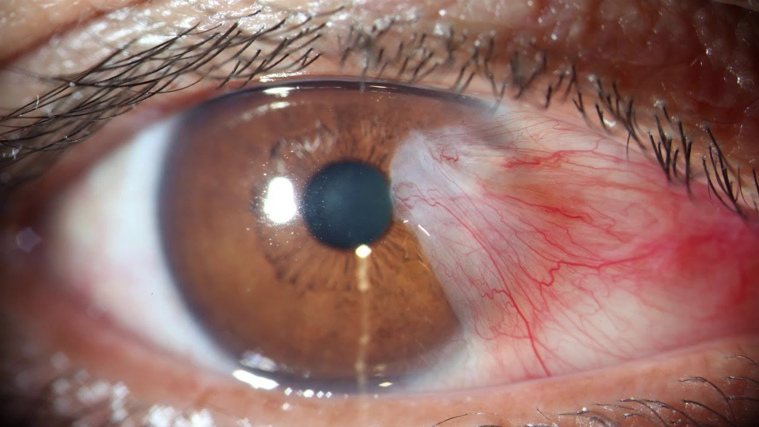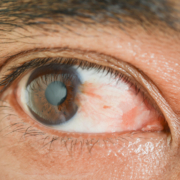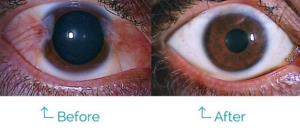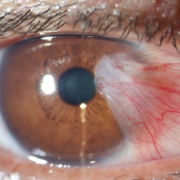Why Is Pterygium Called Surfer’s Eye?

If you spend a lot of time outdoors or on the water, you may have heard the term “surfer’s eye.” This refers to a condition known as pterygium, a noncancerous growth that can cause irritation and blurred vision. Despite its nickname, pterygium does not only affect surfers or those who spend a lot of time in the ocean. The main culprit is excessive exposure to bright sunlight. Exposing your eyes to significant amounts of UV light from the sun puts you at high risk for developing a growth (light reflected from the ocean is what sparked the “surfer’s eye” moniker). Additionally, long-term exposure to windy conditions is also thought to be a cause.
More people than just surfers or those who embrace an outdoor lifestyle are at risk of developing this impairment, so it’s important to understand the broader implications. Pterygium is often associated with environments that are harsh on the eyes, not limited to just aquatic surroundings. Those living in high-altitude areas or places with strong winds and dusty conditions may also be more susceptible. It’s a reminder that our eyes are sensitive to a variety of environmental factors, not just water and sunlight.
Recognizing the risk factors beyond the stereotype of the surfer’s lifestyle highlights the importance of eye protection in diverse settings. Whether you’re a mountain biker, a skier, or someone who enjoys long hikes in sunny locales, safeguarding your eyes against the elements is crucial. This broader understanding of pterygium challenges the misconception that it’s a condition exclusive to certain groups and emphasizes the need for universal eye care practices.
Symptoms of Surfer’s Eye
Often shaped like a wedge, a pterygium is a non-cancerous growth of a mucous membrane filled with blood vessels that cover the white part of your eye (sclera) over the cornea. Though this is a non-cancerous growth but can cause a range of irritating side effects. While it isn’t life-threatening, its impact on one’s vision and eye comfort can be significant.
Symptoms of pterygium include:
- Redness and irritation: This is one of the most common symptoms. The affected area can become inflamed, leading to noticeable redness and in some cases, severe discomfort.
- Dryness or a gritty feeling: Many people with pterygium experience a foreign body sensation similar to having something stuck, often described as gritty or sandy.
- Blurred vision: As the pterygium grows, it can encroach upon the cornea, the eye’s clear front surface, leading to blurred vision. This is due to the irregular surface it creates on the cornea.
- Double vision: In more advanced cases, the growth can alter the shape of the cornea to such an extent that it causes double vision or astigmatism.
- A noticeable growth that affects sight: The physical presence of the pterygium, especially when it extends over the cornea, can obstruct one’s line of sight.
Even in mild cases of pterygium, the primary concern for many individuals is often cosmetic reasons, particularly the appearance of a yellowish patch or growth on the white part of the eye. This discoloration or noticeable growth, although it might not impede vision or cause physical discomfort significantly, can still be a source of self-consciousness or distress for individuals. The presence of this visible irregularity on the eye can affect one’s appearance and, by extension, their social confidence and psychological well-being. Therefore, it is entirely justified for individuals to seek medical help for pterygium, even if their concerns are primarily aesthetic. Eye specialists understand the impact of such conditions on a person’s quality of life and can offer solutions that address both the physical and cosmetic aspects of the condition. In this context, seeking medical intervention for even seemingly minor cosmetic issues is an important step in preserving not only eye health but also personal comfort and self-esteem.
If left untreated, pterygium can spread across the rest of your cornea, so it’s important to have it looked at by a professional during the early stages.
Pterygium Treatment Options
Given its appearance of a wedge-shaped bump, a pterygium is fairly straightforward to diagnose. An eye doctor will be able to determine its presence with a simple examination under bright lighting.
Eye Drops
If the pterygium is not causing vision problems or creating discomfort, it can be left untreated. However, if it is having those effects, you have a couple of treatment options. Over-the-counter artificial tears can help reduce inflammation and reduce redness. In more extreme cases, steroid eye drops may be prescribed to treat irritation.
Pterygium Surgery
Surgical removal is also an option if the eye drops are inadequate or vision becomes more impaired. The surgery, which shouldn’t cause any pain, removes the pterygium from the cornea and sclera of the eye. Performed under local anesthesia, the affected area is then covered with a small tissue graft to aid in healing. Most patients can resume normal activities within a few days to a week after pterygium surgery, depending on individual healing.
Not Just for Surfers – How To Decrease Your Risk
While common in surfers due to the high exposure to UV light, this condition can also be caused by regular contact with harsh elements like sand, smoke, wind, pollen, or chemicals. As a result, people who live or work in warm, sunny environments — such as farmers, landscapers, and construction workers — are most likely to experience symptoms. Thankfully, it is rarely seen in children.
The good news is that there are several ways to protect yourself from pterygium, even if your job or lifestyle requires significant time outdoors. Try these preventative steps:
- Don’t trust any old sunglasses. Make sure you are wearing a pair with proper UVA/UVB protection to limit the sun’s impact.
- Eye Protection such as goggles or a face shield can help keep dusty conditions and other irritants at bay.
- Wear a wide-brimmed hat for extra protection, especially when on the water.
Prioritizing Eye Health in the Fight Against Pterygium
Understanding that “surfer’s eye,” or pterygium, is more than just a concern for those who hit the waves, it’s essential for everyone to take proactive steps in eye care and protection. This condition, marked by a benign growth on the eye, serves as a reminder of the vulnerability of our eyes to environmental elements like UV rays and wind. Symptoms can vary from mild, such as a yellowish discoloration, to more severe cases involving vision impairment.
Therefore, whether you’re a surfer, an outdoor enthusiast, or someone who spends considerable time in harsh environmental conditions, prioritizing eye health is crucial. Consider scheduling regular eye check-ups, especially if you experience any symptoms of pterygium. Embrace protective measures like wearing sunglasses with proper UVA/UVB protection, using eye protection in dusty or windy environments, and donning wide-brimmed hats for additional shade.
Taking these preventative steps not only safeguards your vision but also ensures that you continue to enjoy your outdoor activities with peace of mind. Remember, eye health is an integral part of overall well-being, and taking action today can prevent complications tomorrow. Don’t wait for symptoms to escalate – be proactive in protecting your eyes from the elements.
And remember, if you are ever concerned about a possible pterygium growth on your eye or your risk for developing one, Visionary Eye Doctors is here to help. Book an appointment online to consult with one of our expert technicians.










